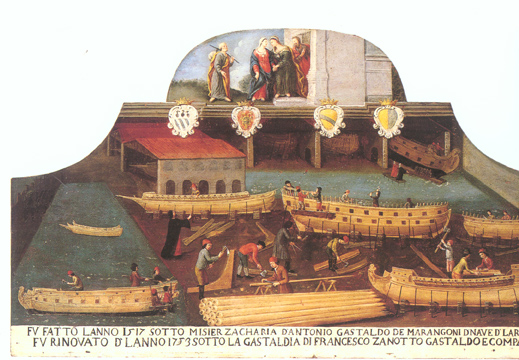Crafts in Venice were organised by a system of Corporations (the "Arti") that were legally recognised by the State at the beginning of the 13th Century (the oldest written rules - the "Capitolare" – belong to the tailors’ guild dated 10th February, 1219).
There were about a hundred such guilds in the 1500s; by 1797, the year the Venetian Republic fell, there were more than 150.
The State controlled them through special courts - such as the Guistizia Vecchia (Old Justice) - to ensure they did not aspire to any effective political power or participation in government, as had happened in Florence.
These guilds were, at the same time, protected and supported to keep alive "popular consensus" and the social function of aggregation believed to be so important for good governance of the Republic.
The organization and relations with the State and with the outside world of each guild were governed by rules contained in its particular Capitolare. The head of each guild was the "gastaldo", chosen from among the most capable craftsmen and experts and assisted by other figures, such as the Massaro, the "tansadori" (responsible for taxes), the "sindici" (auditors) and the "scrivano" (secretary).
People could only join these guilds or corporations by affiliation or apprenticeship, first as a "garzone" and then as a "lavorante", the period of apprenticeship varying between 7 and 10 years.
Artisans then had to sit a practical test to demonstrate their skills and so qualify as a "Capomastro", master builder, and be registered with the guild.
Certain artisans, such as the \n\nThis file was not retrieved by Teleport Pro, because the server reports that this file cannot be found. \n\nDo you want to open it from the server?'))window.location='http://www.venicethefuture.com/schede/uk/>
Certain artisans, such as the '" tppabs="http://www.venicethefuture.com/schede/uk/>
Certain artisans, such as the "catecumeni" (converted) and the orphans of the "Istituto della Pieta" enjoyed free access, while membership of certain guilds was reserved exclusively for Venetian artisans and/or from the Veneto region.
Guild members were called "colonnelli" and were often further distinguished by their respective skills; they were expected to abide by a set code of ethics, involving moral and material assistance for weak or elderly fellow members, their widows and orphans, as well as devotions during the Feast of the Patron Saint and the commemoration of the dead.
In addition to these legally recognised guilds was another system for seasonal, temporary and virtually illegal workers: the watercolours by Giovanni Grevembroch and engravings by Gaetano Zompini show this to be highly colourful and imaginative .
During large public holidays, the guilds had their own role to play. One such case is Giovedì grasso .
They also took part in the Doge’s processions – for example during Corpus Domini – and on Ascension Day, the Sensa, when small workshops were set up in St. Mark’s Square to show off and sell the finest and most typical crafts of Venice.
Michela Dal Borgo




